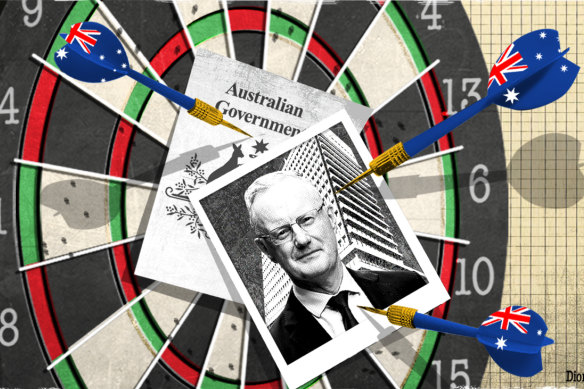The cost-of-living crisis is real, but are we blaming the wrong people?

The Reserve Bank is inflicting pain on mortgage holders and, unsurprisingly, they don’t like it. Monetary policy has been tightened at the fastest pace since inflation targeting began in the early 1990s and consumer sentiment measures are at recessionary levels.
The cost of living is biting, and mortgage pain is the bitter cherry on a cake that’s suddenly doubled in price. When we’re stressed, it makes us feel better to have a face to blame. But should Philip Lowe and the RBA be pinned to the bullseye on the dartboard?
Illustration: DionneCredit:
Perhaps our ire should be directed at the federal government instead. Nasty bracket creep and a bit of post-COVID tax catch-up are zapping more household income than higher interest rates. Last week’s labour force data showed the jobs market is super-strong. Just over 13.8 million people had a job in February and 70 per cent of them worked full-time. There are more Australians working than ever before, and together they are putting in a record number of hours. The total wages and salaries paid to them is also at record levels.
This is resulting in a big uptick for income tax collections. The latest national accounts tell us that personal income tax paid, less social assistance benefits, was 11.4 per cent of gross disposable household income in the last quarter of 2022. There hasn’t been a higher ratio since the giddy days of 1989.
What’s extraordinary is the speed of the increase. Personal income tax paid, less social assistance benefits, was only 7.8 per cent of gross household disposable income in the last quarter of 2021. If you prefer dollars, that’s an additional $13.9 billion of tax being paid by households in just 12 months.
This is in part due to people earning higher nominal wages being pushed into higher tax brackets (aka bracket creep). It’s also small enterprises (which fall into the definition of households here) paying the tax that was deferred during COVID-19 lockdowns.
Mortgage interest repayments increases were smaller. These increased from 3 per cent to 5.4 per cent of gross disposable income. That’s an additional $9.1 billion in a year.
Government finance statements tell us that the tax-take is billions more than the government expected as recently as the October 2022 budget. More precisely, total individual and other withholding taxation is $3.6 billion more than estimated back then.
The silver lining to this otherwise taxing tale, is that it mostly reflects a household sector that is “jobbed-up” and earning good income. So, is the whinging about higher mortgage rates a bit overdone? Not exactly.
Total gross income rose 5.4 per cent in the year to the December quarter, but disposable gross income rose only 3.3 per cent (that’s once tax and interest repayments are taken out). Once you factor in inflation of more than 7 per cent, fewer households can spoil themselves on takeaway night. And of course, some are having to give up a lot more than a Friday-night treat.
RBA assistant governor Christopher Kent.Credit:Bloomberg
Importantly, as RBA assistant governor Christopher Kent reminded us this week, monetary policy has long and variable lags. That means some households haven’t yet felt the full whack of higher interest rate payments. Many are likely terrified of the damage to be inflicted when they fall over the so-called mortgage cliff – when the low fixed rate mortgages locked in during the pandemic expire.
The Reserve Bank estimated that scheduled mortgage payments are projected to reach a new record this year (and their calculations don’t include potential further rises).
Will the tax-take get much higher? It will increase, but interest rates will drain disposable income more. Most of the labour market improvement is likely to be behind us because the economy is slowing. Also, some of the latest surge in tax receipts is “catch-up” tax that won’t need to be repaid.
The numbers beg the question: are the stage three tax cuts so bad if they put a bit more money back into already squeezed household budgets? If we think that households deserve a break from tax brackets that don’t reflect inflation – when real wages are falling and interest rates are rising – then yes. The tax cuts due to start in July 2024 will benefit people with annual incomes starting at just $45,000. That’s not a high salary.
But the answer is no if we are more concerned that additional dollars in consumers’ pockets are inflationary – especially when the public sector as a whole is making its own contribution to inflation with enthusiastic spending.
On balance, I think the stage three tax cuts are reasonable because they will land when our inflation problem is behind us. In many ways, these are not even stimulatory when viewed over a multi-year horizon because they are just returning the tax that inflation rushed.
From an equity perspective, there is a strong argument to reconfigure the tax cuts to consider the impact of changes across different income groups in the economy. Mortgage holders who have recently taken on debt should, most sensibly, be given tax relief – although that’s easier said than done.
It also highlights that the Reserve Bank is the best institution to manage inflation. Monetary policy is flexible and can be quickly adjusted to suit the economic times, although it is far from perfect from an equity perspective. Fiscal policy is multilayered, slow to implement and can often create unintended economic consequences.
The sad reality is that super-loose fiscal and monetary policy settings during the pandemic were a significant part of the reason we have an inflation problem now. If loose policy had not been reversed, high levels of inflation would have continued, and that’s not in anyone’s interest – especially those on low incomes.
If inflation took the cost of a loaf of bread to $20, imagine the cost of takeaway night. It would be a treat reserved for the very few. So be careful whose face you pin to the dartboard. It could be the wrong one.
The Opinion newsletter is a weekly wrap of views that will challenge, champion and inform your own. Sign up here.
Most Viewed in Business
From our partners
Source: Read Full Article


